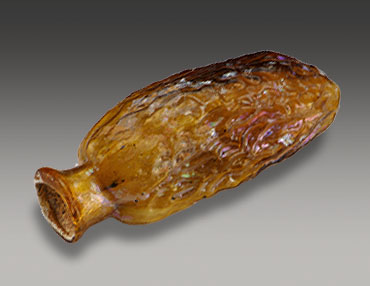
Roman Date Shaped Flask
Roman Empire/Syrian Coast
50~125 A.D.
Around the ancient Mediterranean coastlines, date palms prospered and their fruit was a popular treat. Inspired, the Roman Empire’s budding glass industry started producing small bottles shaped and colored like a date beginning about 50 AD. Merchants would fill them with cosmetic oils or medicinal salves to sell in the market.
The coast was an ideal location for making glass. Beach sand was plentiful. Natron, another important ingredient came from the dry lake beds of Wadi El Natrun in Egypt. (Natron was the also used in the mummification process for the Egyptians.) Lastly, the rich, amber coloring was achieved by adding powdered iron and sulphur to the hot glass.
Using a clay blowpipe, a dollop of hot glass was carefully blown into a two- or three-part date-shaped mold and then carefully removed to cool. The neck and lip of the flask were made separately and attached to the vessel. Finally, a stopper of dried clay sealed the mouth.

Owing to their popularity, these vials were likely displayed at the street markets and sold to the wandering tourists. They have subsequently been uncovered throughout the Mediterranean.
The times that these glass vials were produced were full of uncertainty. The crucifixion of Christ had occurred around two decades earlier. Emperor Nero, who was considered a corrupt tyrant ruled. Under him, the Great Fire of Rome destroyed over two thirds of the city, and was blamed on the Christian community.
The mold-blown date flask specimen was acquired through a Superior Galleries auction in Beverly Hills in the early 1990s. It was sold at auction in 2011.